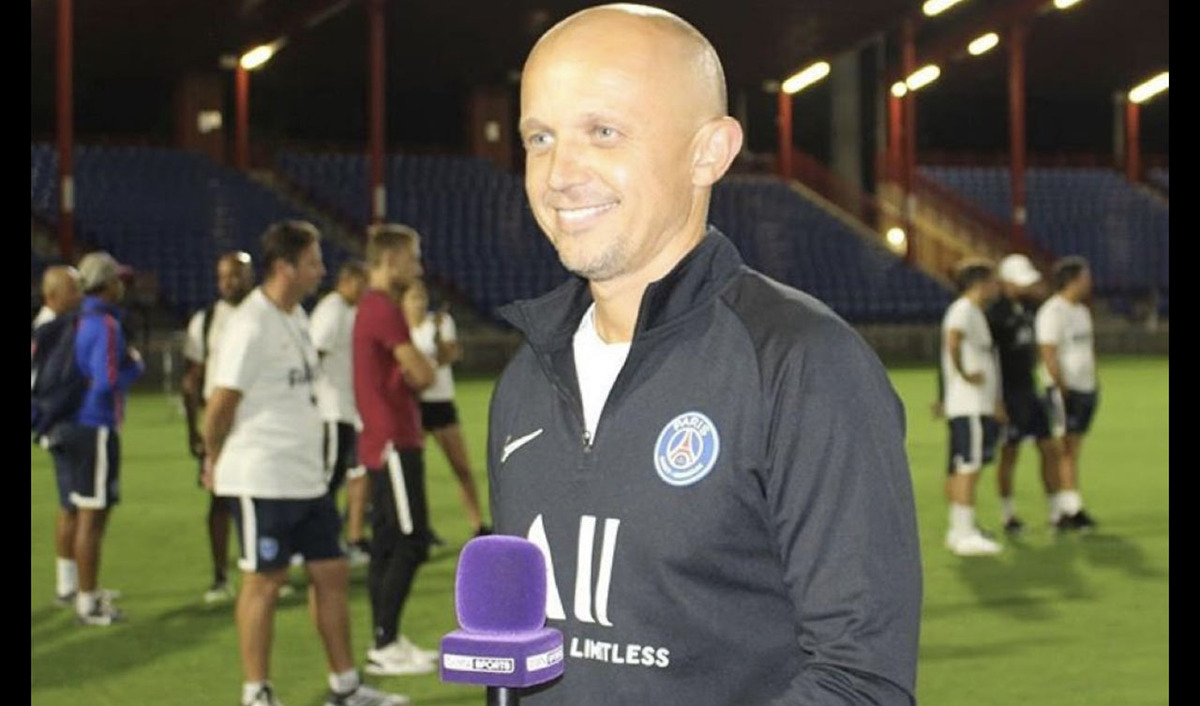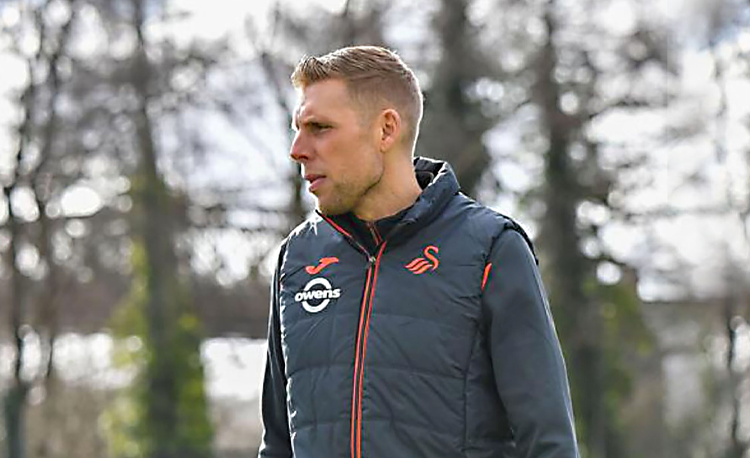You are viewing 1 of your 1 free articles
Better finishing
| Area | Half a pitch |
| Equipment | Balls, bibs, cones, 3 mannequins, 2 mini target goals, 2 full size goals |
| No. of Players | Up to 18 players + 2 goalkeepers |
| Session Time | Conditioned finishing game: 25mins Technical shooting practice: 25mins Competitive free play: 25mins |
This session is designed to support and develop a range of finishing skills in and around penalty area. It is a very realistic session with plenty of opportunities for players to practise finishing within a game environment. With these exercises the players are not only working on improving their individual techniques but also on improving their decision making.
Players usually tend to love this session because it revolves around scoring goals and it is made up of intensive and competitive free flowing games and drills.
I would run this session once a week. Normally it would be the last session before a game at the weekend and I would use either the full session or parts of it, depending on how much tactical work needs to be done on the pitch.
“Players usually love this session because it revolves around scoring goals and it is made up of intensive and competitive free flowing games”
CONDITIONED FINISHING GAME
We set up a playing area the size of two penalty boxes with a full size goal and a goalkeeper at each end. Both penalty boxes are coned off to a width of 36 yards and each has a 5-yard side box on each side of the playing area and a triangular box marked in the corners of the playing area, as shown.
We’re using 16 outfield players split into two teams of nine including the goalkeepers. It’s 4v4 in the main playing area and each team has two target players to play to in the triangular boxes on either side of the goal they are attacking. The target players are limited to one-touch. Each team also has two wide rotational players, who are locked into their side boxes in the defensive half of their team’s playing area until the ball is played into them.
The aim for the team in possession of the ball is to play through the opposition and score. The possession team can attack using a forward pass played into a target player in the triangular box next to the goal, who lays the ball off with one-touch for a player in the central area to finish with a shot on goal, as shown in the below diagram [1a].
[1a]
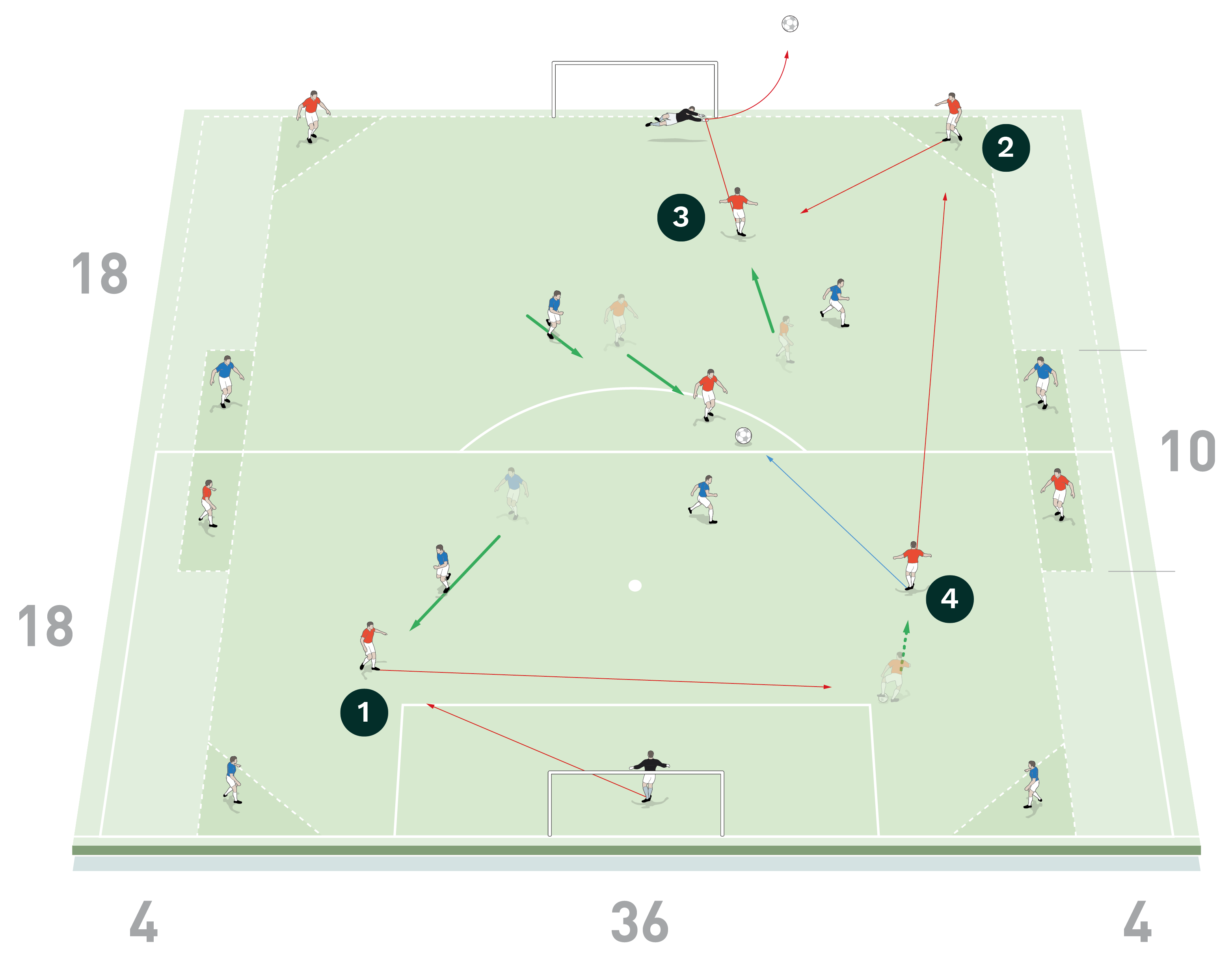
2. Here the reds attack using a forward pass played into a target player in the triangular box next to the goal
3. The target player lays the ball off with one-touch for a team mate in the central area to finish with a shot on goal
4. Alternatively the reds could build play gradually with a pass into the opposite half
[1b]

2. On receiving the ball, the wide player can dribble into the main playing area in the same half and is replaced in the side box by the player who passed the ball in
3. The reds then continue the attack with the aim of producing quick combination play to create a scoring opportunity
“The team in possession continues the attack with the aim of producing quick combination play to create goal scoring opportunities”
Alternatively, the ball can be passed into a wide rotational player in a side box. On receiving the ball, the wide player can enter the central area in the same half and is then replaced in the side box by the player who passed the ball to them, as shown [1b]. This maintains the 4v4 situation in the central area. The team in possession then continues the attack with the aim of producing quick combination play to create goal scoring opportunities. However, goals only count if the side boxes are occupied.
TECHNICAL SHOOTING PRACTICE
We set up a playing area on the final third of the pitch with a full size goal and a goalkeeper at one end and two mini target goals at the other end. To begin with three mannequins are positioned around the edge of the penalty area as static defenders.
We are using at least 12 outfield players starting in three attacking lines as shown, with player 1 coming from the line of players on the left, player 2 coming from the central line and player 3 coming from the line of players on the right.
Each player starts with a ball at their feet. Play starts with player 1 who dribbles from the left past the mannequin and shoots at goal. Player 2 then dribbles towards the central mannequin and plays a one-two combination with player 1 before shooting at goal. Player 3 then dribbles forward from the right towards the mannequin and plays a one-two combination with player 2 before shooting at goal, as shown [2a]. This drill runs continuously with three balls working at a time.
[2a]

2. Player 2 then dribbles towards the central mannequin and plays a one-two combination with player 1 before shooting
3. Player 3 then dribbles forward from the right towards the mannequin and plays a one-two combination with player 2 before shooting
“Each player starts with a ball at their feet. This drill runs continuously with three balls working at a time”
[2b]
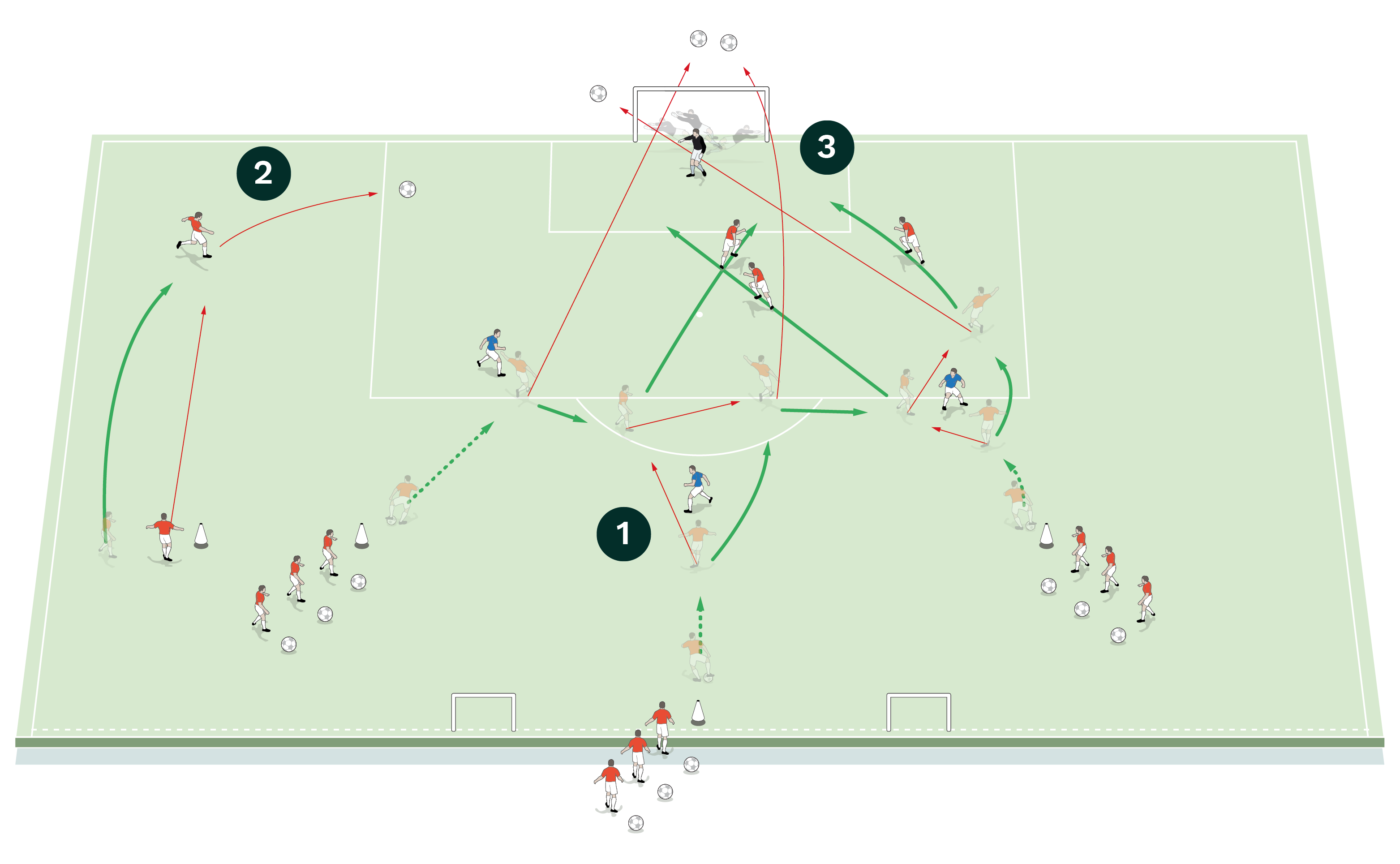
2. The drill runs as before but after the third attack, a fourth ball is crossed in from a new wide player on the left wing
3. Players 1, 2 and 3 now make attacking runs to meet the cross and one finishes with a shot on goal
[2c]
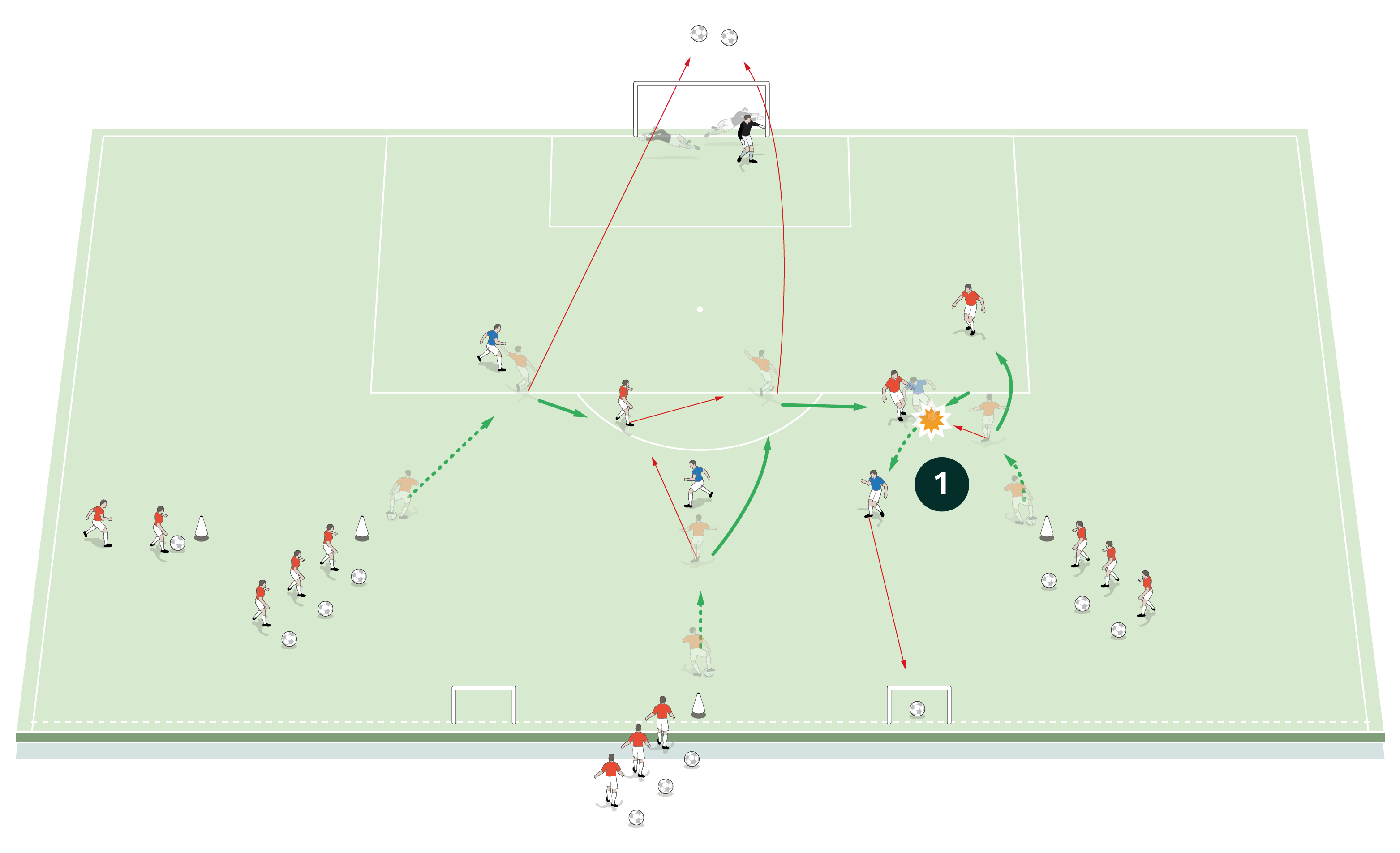
We progress the drill by replacing the three mannequins with three live defenders and by adding an additional line of wide players with a fourth ball. The drill runs as before, but after the third attack has played out, one wide player feeds a fourth ball to a winger who receives on the move and crosses into the goalmouth for player 1, player 2 and player 3 who make attacking runs to meet the cross, as shown [2b].
If the defenders win the ball from the attackers at any time during the drill, they have the option to score in one of the two mini goals, as shown [2c].
COMPETITIVE FREE PLAY
We set up a playing area the size of two penalty boxes with a full size goal and a goalkeeper at each end. We’re using 18 outfield players split into three teams of six. Two teams play against each other in a 6v6 in the main area, while the players of the remaining team are positioned around the edge of the playing area,
as shown [3].
Play starts with a pass from the goalkeeper and the aim for the possession team is to build an attack on the opposite goal, using the support of the outside players if needed. The outside players are limited to two-touch at the most.
We play six games of four minutes, with each team having two turns to play on the outside.
[3]
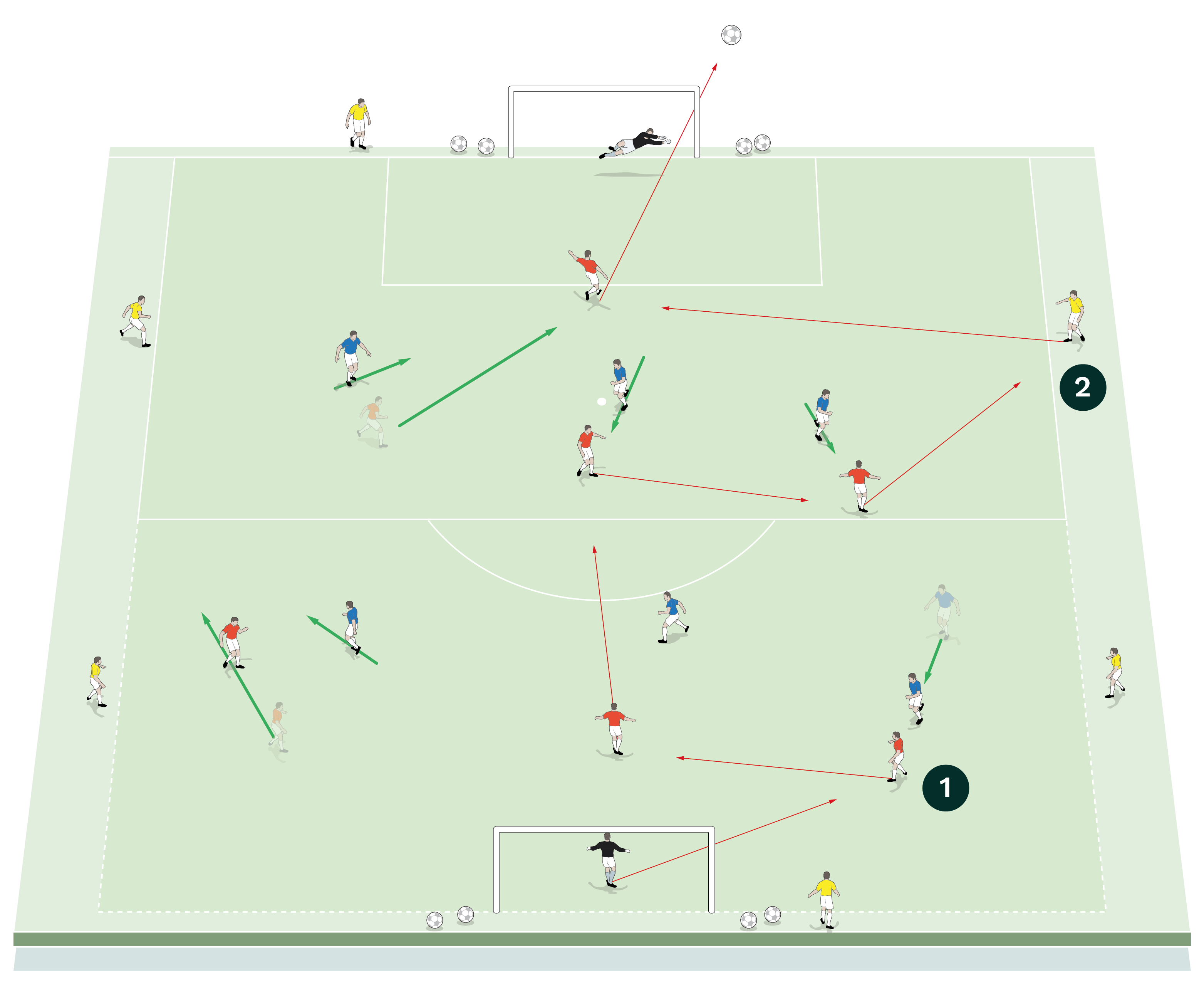
2. The possession team can combine with the outside players if needed. The outside players are limited to two-touch
COACHING POINTS
What are the key things to look for?
As this is a finishing session, the first thing to consider before anything else is a positive attitude to scoring. Players need to be brave and look for the earliest shooting opportunity. Being aware of the position of the goal, the goalkeeper, and the nearest danger will be important learning objectives.
Demonstrating a confidence and a desire to go again after a failed attempt is also important, meaning that the psychological corner must be covered and coached in this session.
In the technical corner, the coach looks for a range of shooting and finishing techniques and wants to see good ball control under pressure.
Tactically players need to look to make good decisions both on the ball and off it, showing an awareness of space and of danger, and an understanding of how to support. Players should be able to read the game and anticipate opportunities.
What are the typical mistakes players might make and how do I avoid them?
Sometimes players are not brave enough to go for the goal as early as possible, or they make a decision to pass the ball around to create the perfect opportunity to shoot at goal. The clear message from the coach should be that players must be as positive as possible and look to shoot at the earliest opportunity.
Related Files
Editor's Picks
Deep runs in the final third
Using the goalkeeper in build-up play
Pressing principles
Intensive boxes drill with goals
Penetrating the final third
Creating and finishing
My philosophy
Pressing initiation
Compact team movement
Coaches' Testimonials

Alan Pardew

Arsène Wenger

Brendan Rodgers

Carlos Carvalhal

José Mourinho

Jürgen Klopp

Pep Guardiola

Roy Hodgson

Sir Alex Ferguson

Steven Gerrard
Coaches' Testimonials

Gerald Kearney, Downtown Las Vegas Soccer Club

Paul Butler, Florida, USA

Rick Shields, Springboro, USA

Tony Green, Pierrefonds Titans, Quebec, Canada
Join the world's leading coaches and managers and discover for yourself one of the best kept secrets in coaching. No other training tool on the planet is written or read by the calibre of names you’ll find in Elite Soccer.
In a recent survey 92% of subscribers said Elite Soccer makes them more confident, 89% said it makes them a more effective coach and 91% said it makes them more inspired.
Get Monthly Inspiration
All the latest techniques and approaches
Since 2010 Elite Soccer has given subscribers exclusive insight into the training ground practices of the world’s best coaches. Published in partnership with the League Managers Association we have unparalleled access to the leading lights in the English leagues, as well as a host of international managers.
Elite Soccer exclusively features sessions written by the coaches themselves. There are no observed sessions and no sessions “in the style of”, just first-hand advice delivered direct to you from the coach.
